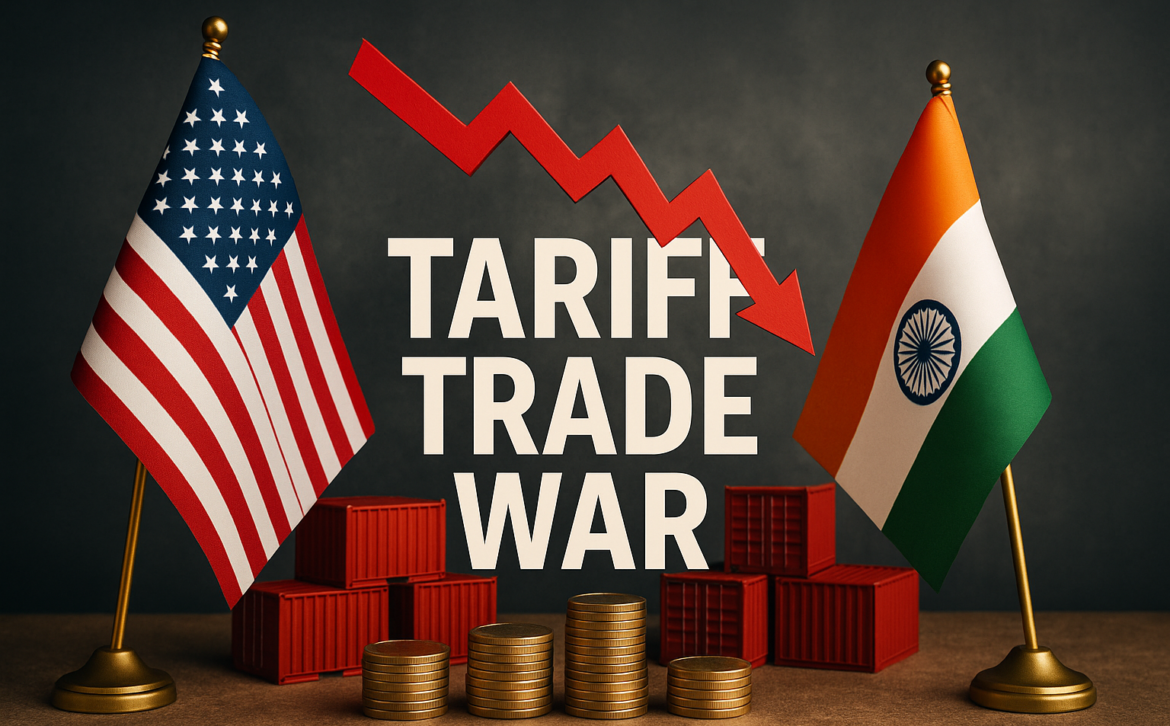In continuation of his trade war against various trading partners, U.S President Donald Trump has now set his sights on India by implementing punitive tariffs that have now reached 50% on Indian goods as punishment for New Delhi’s continued energy purchases from Russia. This unprecedented move marks one of the most significant trade disputes of Trump’s second term and highlights the complex challenges of enforcing Western sanctions against Russia.
The conflict began in late July 2025 when Trump first threatened India with a 25% tariff on all imports, specifically citing the country’s continued trade relationship with Russia. Initially announced to take effect August 1st, the tariff was positioned as both a response to India’s historically high trade barriers and its energy purchases from Moscow.
The situation escalated rapidly in early August when Trump doubled down on his threats. In a series of social media posts and public statements, he announced an additional 25% “penalty” tariff, bringing the total to 50% on Indian goods. This dramatic increase came after negotiations between the two countries appeared to stall and India showed no signs of reducing its Russian oil imports.
The president has been explicit about his reasoning for targeting India. He argues that India’s massive purchases of Russian oil and military equipment directly undermine Western efforts to isolate Russia economically following its invasion of Ukraine. Trump has characterized India as “Russia’s largest buyer of energy, along with China,” and has accused New Delhi of fuelling the Russian war machine through these transactions.
Beyond the Russia connection, Trump has also cited India’s traditionally high tariffs on American goods as justification for reciprocal measures. He has long complained about what he views as unfair trade practices by various countries, and India’s tariff structure has been a particular target of his criticism.
India has responded to Trump’s tariff threats with unprecedented defiance, calling the measures “unfair, unjustified, and unreasonable.” The country’s Ministry of External Affairs has pushed back strongly, arguing that India is being unfairly singled out when other nations, including the United States and European countries, continue to trade with Russia in various capacities.
Indian officials have pointed out what they see as hypocrisy in the American position. They note that U.S. bilateral trade with Russia in 2024 stood at $5.2 billion, while highlighting that the United States has not imposed “reciprocal tariffs” on Russia itself. This argument forms the core of India’s defence: that it is being targeted for behaviour that other nations, including America’s closest allies, continue to engage in.
Prime Minister Narendra Modi’s government has shown little inclination to bow to American pressure. Indian trade officials have suggested that the country should allow the tariffs to take effect, arguing that American consumers and importers will ultimately bear the cost. They contend that any loss of exports to the U.S. can be compensated through increased domestic consumption or by finding alternative export markets.
India’s continued purchase of Russian oil is driven by compelling economic factors. As one of the world’s largest energy importers, India has benefited significantly from heavily discounted Russian crude oil that became available after Western sanctions made Moscow a pariah in international energy markets. These purchases have helped India manage its energy costs and maintain economic stability during a period of global inflation.
The scale of India’s Russian energy imports is substantial, making it one of Moscow’s most important customers alongside China. This relationship has provided Russia with crucial revenue streams despite Western sanctions, which explains Trump’s frustration with what he sees as India undermining collective Western pressure on the Kremlin.
Trump’s tariff war with India represents a significant test case for how the United States will handle countries that maintain economic ties with Russia. The aggressive approach toward India, a key strategic partner in the Indo-Pacific region and a member of the Quad alliance alongside the U.S., Australia, and Japan, signals that Trump is willing to risk important relationships to enforce his vision of economic pressure on Russia.
The dispute also highlights the complex realities of global sanctions enforcement. While Western nations have imposed comprehensive sanctions on Russia, many countries, particularly in Asia and the Global South, have continued various forms of economic engagement with Moscow. Trump’s approach to India suggests a more confrontational stance toward these nations than was taken during his first presidency.
The 50% tariff on Indian goods represents a significant barrier to bilateral trade between the world’s largest democracy and its most powerful. Indian exports to the United States span a wide range of sectors, including textiles, pharmaceuticals, information technology services, and various manufactured goods. The tariffs will likely increase costs for American consumers and businesses that rely on Indian products and services.
For India, the tariffs pose challenges but also opportunities. While some sectors may suffer from reduced access to the American market, the Indian government appears confident that alternative markets and domestic demand can absorb much of the impact. This confidence reflects India’s growing economic strength and its increasingly diversified trade relationships.
The Trump-Modi confrontation over Russian energy trade appears far from resolved. With both leaders taking strong public positions, compromise may prove difficult without significant face-saving measures for both sides. The dispute tests not only bilateral economic relationships but also broader geopolitical alignments in an increasingly multipolar world.
The outcome of this tariff war will likely influence how other nations approach their relationships with Russia and their trade ties with the United States. It may also signal whether Trump’s second term will be characterized by the same aggressive use of economic tools that defined much of his first presidency’s foreign policy approach.
As negotiations continue, the world watches to see whether economic pressure can force a major power like India to fundamentally alter its energy security strategies, or whether Trump’s tariff weapon will prove less effective against a confident, economically strong nation willing to call his bluff.
Oshobi, a development economist, management consultant, and author, writes from Lagos, Nigeria

